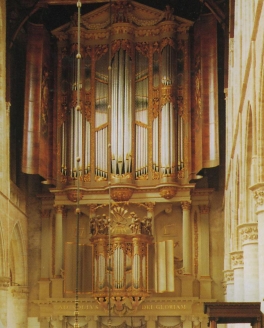Open diapasons
The register Open Diapason/Principal (from lat. vox principalis" main voice) is the most important rank of the organ. As far as possible, the organ builders place this rank in the façade of the organ (hence the name "Prästant" of lat. praestare) (Fig. 1). It is usually made of an alloy with a particularly high tin content of more than 75% in order to give a highly valued silver shine to the organ.
The Diapason pipes are cylindrical and open at their ends. The specific width to length ratio allows to build the register in all conceivable ranges, from 32' to less than 1'; thus they establish the sonic backbone of the organ („Plenum").
In addition, it has become customary to calculate and specify the measurements of the other labial ranks in relation to the diapasons, although the diapason dimensions are slightly different in some countries. As a rule of thumb, a ratio of about 15:1 to 16:1 between the length of the pipe and its diameter is considered appropriate. From one tone to the next higher semitone, the pipe is shortened by about a sixteenth and the diameter narrowed similarly (Pythagorean semitone ratio 15:16).
Diapasons take a middle position in sound character between relatively overtone-rich pipes with a weak keynote (narrower diameter - 17:1 to about 24:1 - than diapason) and overtone-poor pipes with a strong keynote (with a wider diameter - 14:1 to about 10:1) a. They produce distinct fundamentals and a relatively rich spectrum of harmonics.
The octave series of an organ (with names such as Octava, Superoctava, Sedecima [actually: Quintadecima] etc.) are also diapasons, but are usually placed inside the organ, as well as diapasons made of wood.
Depending on the available space and room acoustics, the organ builders endeavour to put tha biggest diapasons in the façade. So the approximate size of the organ or the organ part and the lowest occurring principal register are related. A "two-feet" organ, for example, would be a small organ for the house, possibly even portable, a "four-feet" organ a larger house or small church organ (also called "quarter organ" by organ builders), an "eight-feet" organ ("half organ") to fill a larger room, a "sixteen-feet" organ represents a very stately work, which rises high into the room ("whole organ").
Especially in the Netherlands and occasionally in northern Germany there were even attempts to build monumental organs with 32' pipes (Fig. 2). But in trying this, problems were encountered that were difficult to overcome. The dimensions of a 32' pipe for C (sounding C'' of c. 16 Hz) with a length of more than 10 meters (including the foot) were impressive, but their weight brought complications both for the pipe itself, which threatened to bend under its own weight, and for the substructure, and everything else below if it should fall down.
The amount of wind required by such pipes was gigantic, and the organ builders had to come up with special solutions for wind supply, unless the rest of the ranks suddenly get too little wind when such a wind-eater is pulled. When such a thing happened, the organ started howling, a phenomenon which, in a very weak form, could have an invigorating effect on the sound of the organ, but in an unfavourable case made further listening highly undesirable. Moreover, although the sight of such pipes was tremendously impressive, the sound produced – very close to the lowest hearing limit of the human being and not audible for everyone - was occasionally not at all, a slow, dull and inevitably quiet humming was all that could be elicited from these gigantic pipes.
[Any modern attempts to build even lower pipes than 32‘ are inaudible for humans. So if not intended for music making for elephants the best that can be achieved in the lowest octave are a beating sensation not unlike a hovering helicopter, or sickening vibrations of the listeners‘ stomachs, … or nothing at all, except the horrendous price).
© Greifenberger Institut für Musikinstrumentenkunde | info@greifenberger-institut.de





